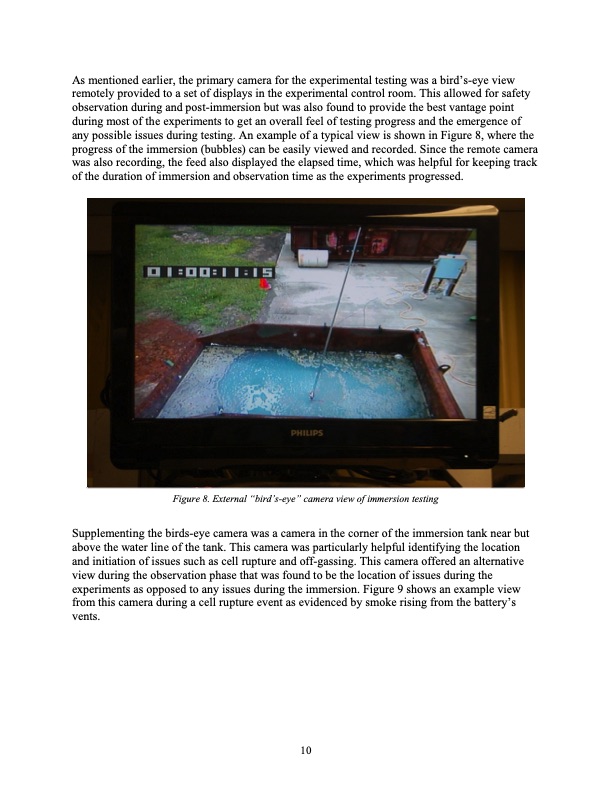
PDF Publication Title:
Text from PDF Page: 014
As mentioned earlier, the primary camera for the experimental testing was a bird’s-eye view remotely provided to a set of displays in the experimental control room. This allowed for safety observation during and post-immersion but was also found to provide the best vantage point during most of the experiments to get an overall feel of testing progress and the emergence of any possible issues during testing. An example of a typical view is shown in Figure 8, where the progress of the immersion (bubbles) can be easily viewed and recorded. Since the remote camera was also recording, the feed also displayed the elapsed time, which was helpful for keeping track of the duration of immersion and observation time as the experiments progressed. Figure 8. External “bird’s-eye” camera view of immersion testing Supplementing the birds-eye camera was a camera in the corner of the immersion tank near but above the water line of the tank. This camera was particularly helpful identifying the location and initiation of issues such as cell rupture and off-gassing. This camera offered an alternative view during the observation phase that was found to be the location of issues during the experiments as opposed to any issues during the immersion. Figure 9 shows an example view from this camera during a cell rupture event as evidenced by smoke rising from the battery’s vents. 10PDF Image | Li-Ion Battery Pack Immersion Exploratory Investigation

PDF Search Title:
Li-Ion Battery Pack Immersion Exploratory InvestigationOriginal File Name Searched:
dot_57013_DS1.pdfDIY PDF Search: Google It | Yahoo | Bing
Product and Development Focus for Salgenx
Redox Flow Battery Technology: With the advent of the new USA tax credits for producing and selling batteries ($35/kW) we are focussing on a simple flow battery using shipping containers as the modular electrolyte storage units with tax credits up to $140,000 per system. Our main focus is on the salt battery. This battery can be used for both thermal and electrical storage applications. We call it the Cogeneration Battery or Cogen Battery. One project is converting salt (brine) based water conditioners to simultaneously produce power. In addition, there are many opportunities to extract Lithium from brine (salt lakes, groundwater, and producer water).Salt water or brine are huge sources for lithium. Most of the worlds lithium is acquired from a brine source. It's even in seawater in a low concentration. Brine is also a byproduct of huge powerplants, which can now use that as an electrolyte and a huge flow battery (which allows storage at the source).We welcome any business and equipment inquiries, as well as licensing our flow battery manufacturing.| CONTACT TEL: 608-238-6001 Email: greg@salgenx.com | RSS | AMP |